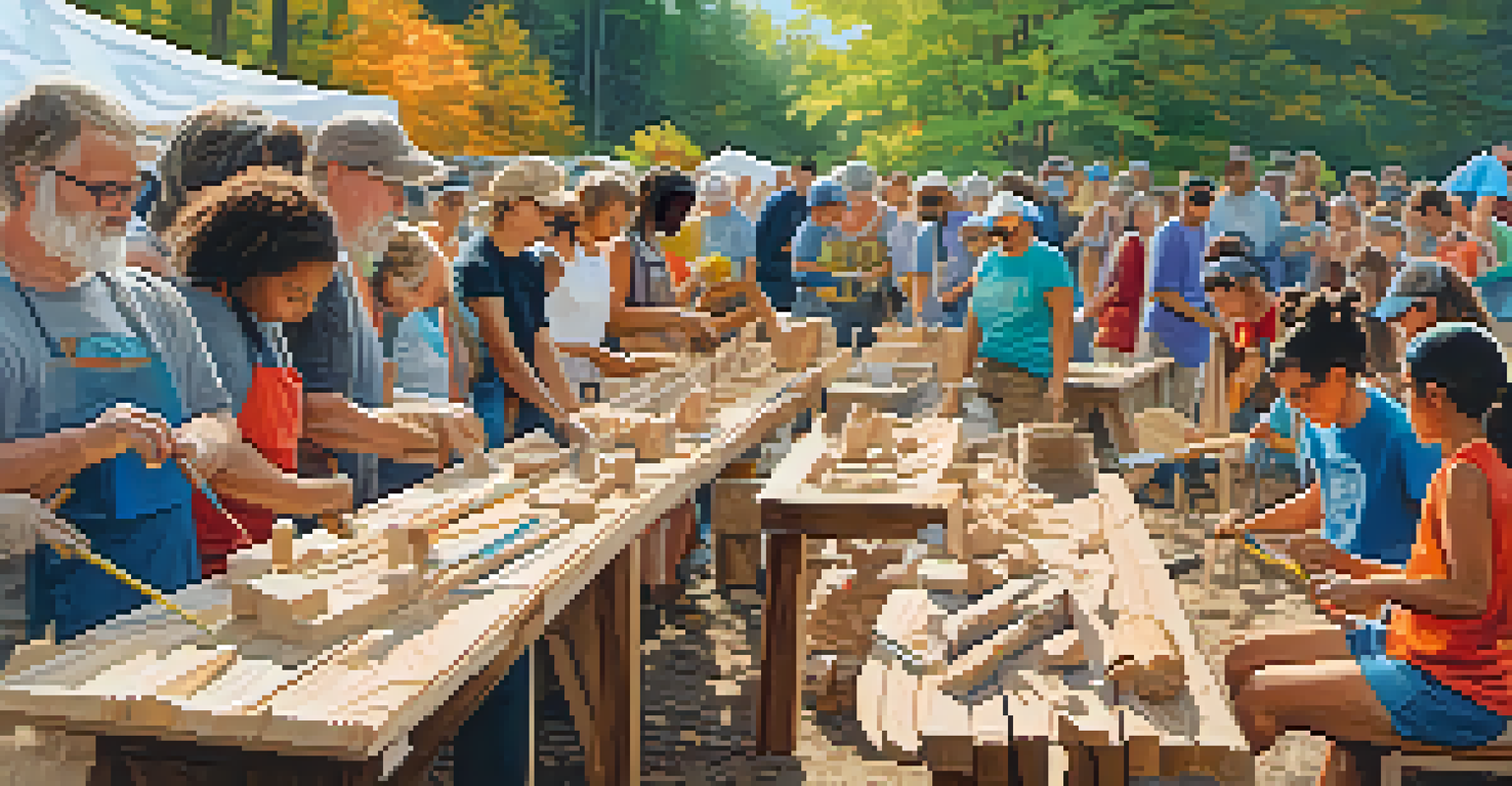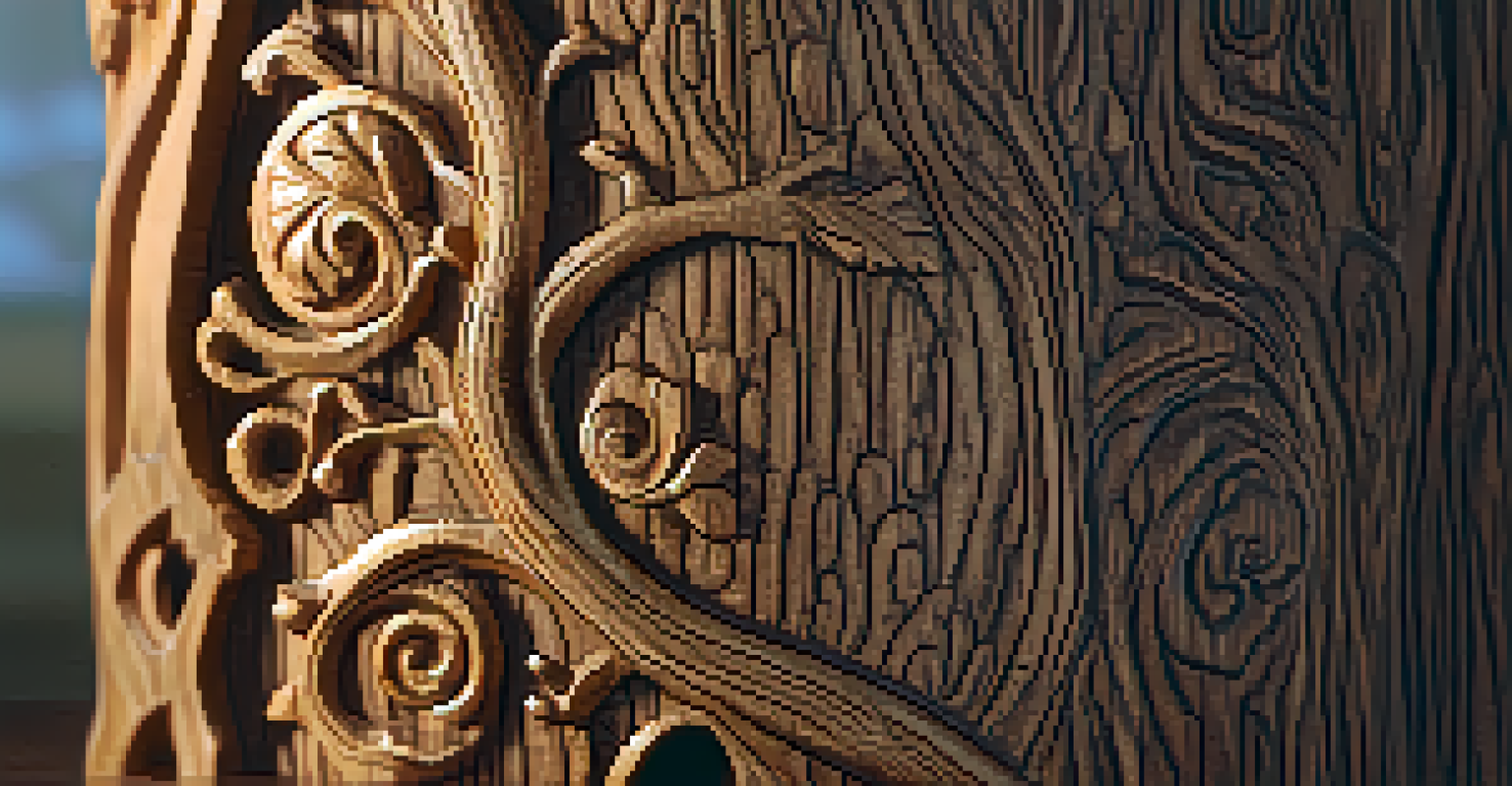Environmental Themes in Carving by Modern Contemporary Artists

The Intersection of Art and Environmental Awareness
Contemporary carving art has evolved beyond mere aesthetics, often reflecting pressing environmental themes. Artists today are increasingly aware of the impact of climate change, deforestation, and pollution. Through their work, they aim to spark conversations and encourage viewers to think critically about their relationship with nature.
Art is not a mirror to reflect the world, but a hammer with which to shape it.
For instance, some carvers use recycled materials to create their pieces, highlighting the importance of sustainability. By transforming discarded wood or plastic into beautiful sculptures, they send a powerful message about waste reduction and environmental responsibility. This intersection of art and activism not only beautifies spaces but also educates the public.
In this way, contemporary carving serves as a medium for storytelling, allowing artists to convey complex messages about the environment. Each piece can be viewed as a call to action, urging society to reflect on its choices and the resulting impact on our planet.
Nature as Inspiration in Modern Carving
Many contemporary carvers draw direct inspiration from the natural world, translating its beauty and fragility into their works. The textures, shapes, and forms found in nature offer endless possibilities for creative expression. By capturing these elements, artists remind us of what we stand to lose if we do not protect our environment.

For instance, some artists create intricate carvings of endangered species, bringing attention to their plight. These pieces not only showcase the skill of the artist but also serve as poignant reminders of the biodiversity at risk. By highlighting these themes, the artists encourage viewers to engage with conservation efforts.
Art as a Voice for Sustainability
Contemporary carving artists are using their work to raise awareness about environmental issues and promote sustainable practices.
Furthermore, the act of carving itself can be seen as a dialogue with nature. As artists work with their materials, they often reflect on the source of their inspiration and the responsibility that comes with it. This connection fosters a sense of stewardship, urging both creators and audiences to cherish and protect the environment.
Sustainable Practices in Contemporary Carving
Sustainability is a central theme for many modern contemporary artists, and carving is no exception. Artists are increasingly sourcing their materials responsibly, opting for wood from sustainable forests or using reclaimed wood. This commitment to sustainability not only reduces the impact on the environment but also adds a unique story to each piece.
The greatest threat to our planet is the belief that someone else will save it.
By incorporating eco-friendly practices, these artists challenge traditional notions of craftsmanship. Their work demonstrates that beauty and sustainability can coexist, inspiring others in the art community to follow suit. This shift toward more responsible sourcing reflects a broader movement within the art world to prioritize ecological integrity.
As audiences become more aware of sustainability issues, they often seek out artists who share their values. This growing demand encourages contemporary carvers to innovate and explore new materials and techniques that align with eco-friendly principles, ultimately fostering a more sustainable art scene.
Community Engagement Through Carving
Many contemporary artists recognize the power of community in addressing environmental issues through carving. By engaging local communities in their work, they create a sense of collective responsibility toward the environment. Workshops and collaborative projects not only empower individuals but also foster a deeper connection to nature.
For example, some artists organize community carving events where participants use local materials to create pieces that reflect their shared environment. This hands-on approach encourages dialogue about local environmental challenges and promotes awareness. As participants carve, they also share stories and ideas about sustainability and conservation.
Community Engagement in Carving
Artists are fostering a sense of collective responsibility by involving local communities in carving projects that address environmental challenges.
Through these collaborative efforts, contemporary carving becomes a tool for social change. Artists and communities work together to craft pieces that symbolize their commitment to protecting the environment, creating lasting bonds that extend beyond the art itself.
Symbolism and Environmental Narratives in Carving
Symbolism plays a crucial role in contemporary carving, particularly when it comes to environmental themes. Many artists use specific symbols to convey messages about nature and its preservation. For instance, a carved tree might represent resilience and growth, while a broken branch could symbolize the fragility of ecosystems.
These symbols invite viewers to interpret the artwork in personal and meaningful ways. Each piece tells a story, often reflecting the artist’s own journey with environmental issues. By embedding these narratives into their work, contemporary carvers engage audiences on both emotional and intellectual levels.
As viewers connect with these symbols, they are encouraged to reflect on their role in the environment. The act of viewing becomes a catalyst for change, prompting individuals to consider how they can contribute to the preservation of our natural world.
Innovative Techniques in Environmental Carving
In the realm of contemporary carving, innovation often goes hand in hand with environmental themes. Artists are experimenting with new techniques and tools that allow them to express their ideas more effectively while minimizing waste. For example, digital carving technology can optimize material use, ensuring that each piece is crafted with precision and care.
Moreover, some artists incorporate mixed media, combining traditional carving with other materials like metal or glass. This blending of techniques not only enhances the visual appeal but also opens up new avenues for storytelling about the environment. By using diverse materials, artists can address various aspects of ecological issues, from pollution to habitat loss.
Innovative Techniques for Change
Modern carvers are experimenting with new materials and technologies to create impactful artworks that highlight ecological themes.
This willingness to innovate reflects a broader trend in the art world, where embracing new methods can lead to more impactful environmental narratives. As artists push the boundaries of traditional carving, they also inspire others to think creatively about how to communicate important messages regarding our planet.
The Future of Environmental Themes in Carving
Looking ahead, the role of environmental themes in contemporary carving is poised to grow even more significant. As global awareness of climate change and ecological issues increases, artists will likely continue to use their platforms to advocate for environmental stewardship. The fusion of art and activism will remain a powerful tool for change.
Furthermore, as technology advances, new opportunities for artists to explore environmental themes will emerge. Virtual reality installations or interactive exhibits could allow audiences to engage with carving in entirely new ways, creating immersive experiences that highlight the beauty and fragility of nature.

Ultimately, the future of contemporary carving lies in its ability to adapt and resonate with societal concerns. By continuing to embrace environmental themes, artists can inspire future generations to cherish and protect the world we inhabit, ensuring that the legacy of their work endures.